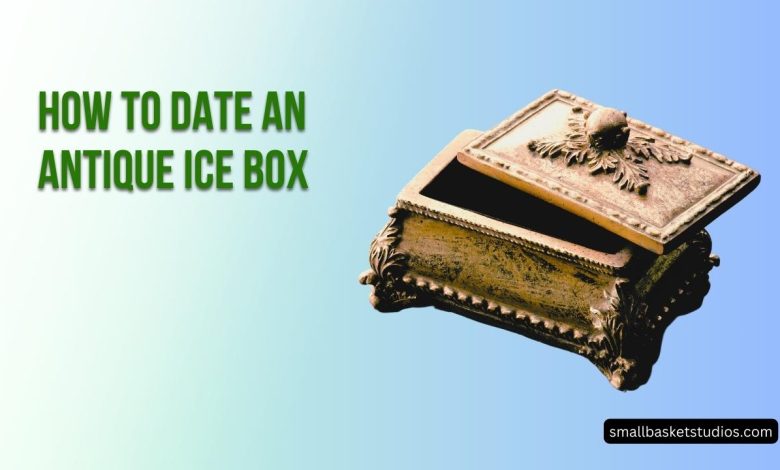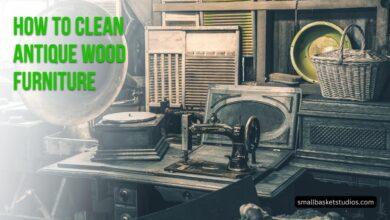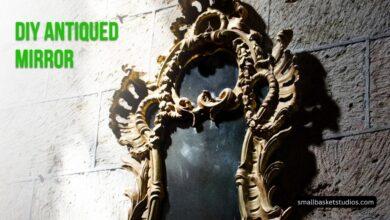How to Date an Antique Ice Box: Tips and Tricks for Collectors

Antique ice boxes are not only functional but also a piece of history. They are a rare find and a great addition to any antique collection. However, dating an antique ice box can be a challenge, especially if you are not familiar with the different types and styles of ice boxes that were used in the past.
Identifying an antique ice box requires a keen eye and an understanding of the different materials, finishes, and colors that were used during different periods. Additionally, understanding the history of ice boxes and how they evolved over time can provide valuable insight into the manufacturing process and help you determine the age of the ice box. Assessing the condition of the ice box is also important as it can affect its value and determine the level of restoration needed.
Key Takeaways
- Identifying an antique ice box requires knowledge of the different types, materials, finishes, and colors used during different periods.
- Understanding the history of ice boxes can provide valuable insight into the manufacturing process and help determine the age of the ice box.
- Assessing the condition of the ice box is important for determining its value and the level of restoration needed.
Identifying an Antique Ice Box
To identify an antique ice box, there are a few key features to look for. Here are some tips to help you determine if you have an antique ice box:
Manufacturer’s Label
The first thing to look for is a manufacturer’s label. This label will typically be located on the front of the ice box or on the back. It will tell you the name of the manufacturer, the model number, and possibly the year it was made. If you can’t find a label, you can try searching online for the manufacturer and model to see if you can find any information about it.
Distortions and Decay
Antique ice boxes are often made of wood, which can warp and rot over time. Look for any distortions or decay in the wood, such as cracks, splits, or missing pieces. This can give you an idea of how old the ice box is and how well it has held up over the years.
Hardware
The hardware on an antique ice box can also provide clues about its age. Look for details such as the type of hinges, locks, and handles. These details can help you determine if the ice box is from the early 1900s or the mid-1900s.
Design Elements
Finally, the design elements of an antique ice box can also help you determine its age. For example, ice boxes from the early 1900s often had decorative elements such as scrollwork or carvings, while those from the mid-1900s were more streamlined and modern-looking.
By examining the manufacturer’s label, distortions and decay, hardware, and design elements of an antique ice box, you can get a better idea of its age and history.
Understanding the History of Ice Boxes
Ice boxes were once a common household item before the invention of modern refrigerators. They were used to keep food and drinks cold by using ice as a cooling agent. Understanding the history of ice boxes can help you date and identify antique models.
The Evolution of Ice Boxes
The first ice boxes were introduced in the early 1800s and were made of wood. They were lined with metal or zinc to prevent the wood from rotting due to moisture. These early models did not have insulation and relied solely on the ice to keep the interior cool.
In the mid-1800s, ice boxes began to evolve with the introduction of insulation. Sawdust, cork, and later, other materials like straw and horsehair were used to insulate the walls of the ice box. This made the ice last longer and reduced the amount of ice needed to keep the interior cool.
By the early 1900s, ice boxes were being mass-produced and sold across the United States. These models were made of porcelain, steel, and other materials, and were often decorated with ornate designs. They were also larger than earlier models and had more space for storing food and drinks.
Famous Manufacturers
There were many manufacturers of ice boxes throughout history, but some of the most famous include Bending Hall, Baldwin, and Ranney. These companies produced high-quality models that were often branded with their names or logos.
Bending Hall was known for producing ice boxes with unique designs, including models with curved tops and ornate metalwork. Baldwin was famous for producing models with wood and alloyed metal sections, which are highly sought after by collectors today. Ranney was known for producing models with a unique “airtight” design, which helped to keep the interior cool for longer periods of time.
Understanding the history of ice boxes can help you date and identify antique models. By looking at the materials, insulation, and design of an ice box, you can determine its age and manufacturer.
Determining the Age of an Ice Box
Antique ice boxes can be a valuable addition to any home, but determining their age can be a challenge. There are several factors that can help in determining the age of an ice box, such as its design and style, materials used, and manufacturer’s marks.
Design and Style
The design and style of an ice box can provide valuable clues about its age. For example, ice boxes from the late 1800s were typically made of wood and had a simple, utilitarian design. In contrast, ice boxes from the early 1900s often featured more elaborate designs, with decorative moldings and carvings.
Materials Used
The materials used in an ice box can also provide clues about its age. Early ice boxes were typically made of wood, while later models were often made of metal. The type of insulation used can also be a clue to the age of an ice box. Early models used sawdust or cork insulation, while later models used materials such as fiberglass or polystyrene foam.
Manufacturer’s Marks
Manufacturer’s marks can be a valuable source of information when trying to determine the age of an ice box. Many manufacturers stamped their name and the date of manufacture on the ice box, which can be found on the back or inside of the unit. In addition, some ice boxes may have a metal tag or plaque with the manufacturer’s name and date of manufacture.
Overall, determining the age of an antique ice box requires careful examination of its design, materials, and manufacturer’s marks. By taking these factors into consideration, it is possible to get a better understanding of the history and value of an ice box.
Assessing the Condition of the Ice Box
When dating an antique ice box, it is important to assess its condition to determine its value and authenticity. Here are some key factors to consider:
1. Exterior Appearance
The first thing to look at is the exterior appearance of the ice box. Check for any scratches, dents, or other forms of damage. If the paint or finish is worn or faded, it may indicate that the ice box has been heavily used or improperly stored. On the other hand, a well-preserved exterior may suggest that the ice box has been well taken care of over the years.
2. Interior Condition
Next, examine the interior of the ice box. Look for any signs of rust, corrosion, or damage to the metal lining. Check the shelves and compartments for any cracks or chips. If the interior is in good condition, it may indicate that the ice box has been well-maintained and is in good working order.
3. Hardware
The hardware of the ice box is another important factor to consider. Check the hinges, latches, and handles for any signs of wear or damage. If the hardware is original and in good condition, it can add to the value of the ice box. However, if the hardware has been replaced or is in poor condition, it may detract from the value.
4. Insulation
Finally, check the insulation of the ice box. The insulation should be intact and in good condition. If the insulation is missing or damaged, it may indicate that the ice box has been heavily used or improperly stored. Additionally, the type of insulation can provide clues about the age of the ice box. For example, early ice boxes were often insulated with sawdust, while later models used materials like cork or cellulose.
By assessing the condition of the ice box, collectors and enthusiasts can gain a better understanding of its age, value, and authenticity.
Estimating the Value of an Antique Ice Box
Determining the value of an antique ice box can be a challenging task, as it depends on several factors such as the age, condition, rarity, and brand. Here are some factors to consider when estimating the value of an antique ice box.
Age
The age of an antique ice box is one of the most critical factors to consider when estimating its value. Generally, the older the icebox, the more valuable it is. Iceboxes from the late 1800s and early 1900s are considered the most valuable, especially those that are still in good condition.
Condition
The condition of an antique ice box is another crucial factor to consider when determining its value. Iceboxes that are in good condition and have all their original parts are worth more than those that have been restored or have missing parts. Any signs of damage, such as cracks, dents, or scratches, can significantly reduce the value of an antique ice box.
Rarity
The rarity of an antique ice box is another factor that can affect its value. Iceboxes that are rare or unusual, such as those made by less well-known manufacturers or those with unique features, are often more valuable than more common models.
Brand
The brand of an antique ice box can also affect its value. Some brands, such as Bending Hall, Baldwin, or Ranney, are more sought after by collectors and can command higher prices. Additionally, iceboxes with well-known brand names are often more valuable than those with lesser-known or generic brands.
Market Demand
Finally, the current market demand for antique ice boxes can affect their value. If there is high demand for a particular type of icebox, its value may increase. Conversely, if there is low demand, its value may decrease.
Overall, determining the value of an antique ice box requires careful consideration of several factors. Collectors and enthusiasts should do their research and consult with experts to ensure they are getting a fair price for their antique ice box.
Preserving and Restoring an Antique Ice Box
Preserving and restoring an antique ice box requires care and attention to detail. Here are some tips to help you keep your antique ice box in good condition:
- Clean the ice box regularly: Use a soft cloth and mild soap to clean the exterior of the ice box. Avoid using abrasive cleaners or harsh chemicals that can damage the finish. Be sure to dry the ice box thoroughly after cleaning.
- Inspect the ice box for damage: Check the ice box for any signs of damage, such as cracks, dents, or missing parts. Repair any damage as soon as possible to prevent further deterioration.
- Store the ice box in a dry, cool place: Keep the ice box away from direct sunlight and moisture to prevent warping, cracking, or fading of the finish.
- Use the ice box for its intended purpose: If you plan to use the ice box for its intended purpose, be sure to follow the manufacturer’s instructions for use and care.
- Restore the ice box carefully: If you plan to restore the ice box, be sure to use appropriate materials and techniques. Consult with a professional restorer if you are unsure about how to proceed.
Preserving and restoring an antique ice box can be a rewarding experience, but it requires patience and attention to detail. By following these tips, you can help ensure that your antique ice box remains in good condition for years to come.
Frequently Asked Questions
What were old ice boxes lined with?
Old ice boxes were typically lined with materials such as tin, zinc, or porcelain. These materials were used to prevent the ice from melting too quickly and to keep the interior of the ice box clean.
How old are iceboxes?
Iceboxes date back to the early 1800s, but they didn’t become popular until the late 1800s and early 1900s. They were commonly used until the 1930s when refrigerators started to become more widely available.
How old are wooden ice boxes?
Wooden ice boxes were commonly used in the late 1800s and early 1900s. They were eventually replaced by metal ice boxes, which were considered to be more hygienic.
How much did a block of ice cost in 1950?
In 1950, a block of ice typically cost around 25 cents. However, the cost could vary depending on the region and the size of the block.
How to use an antique ice box
To use an antique ice box, simply place a block of ice in the top compartment and store your perishable items in the bottom compartment. Be sure to empty the drip pan regularly to prevent any water damage.
How much does an antique ice box weigh?
The weight of an antique ice box can vary depending on the size and materials used. On average, a metal ice box can weigh anywhere from 100 to 300 pounds, while a wooden ice box can weigh between 150 and 500 pounds.





One Comment